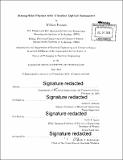Strong-field physics with ultrafast optical resonators
Author(s)
Putnam, William P
DownloadFull printable version (29.66Mb)
Other Contributors
Massachusetts Institute of Technology. Department of Electrical Engineering and Computer Science.
Advisor
Franz X. Kärtner and Erich P. Ippen.
Terms of use
Metadata
Show full item recordAbstract
Light fields from modern high-intensity, femtosecond laser systems can produce electrical forces that rival the binding forces in atomic and solid-state systems. In this strong-field regime, conventional non-linear optics gives way to novel phenomena such as the production of attosecond bursts of electrons and photons. Strong laser fields are generally achieved with amplified, ultrafast laser pulses. In this thesis we explore phenomena unique to strong-fields by using optical resonators to passively enhance ultrafast laser pulses. We pursue two major themes in the area of ultrafast resonator-enhanced strong-field physics. First, we use plasmonic nanoparticles as nano-optical resonators to explore strong-field photoemission near nanostructures on the surface of a chip. We demonstrate strong-field photoemission with our chip-scale devices under ambient conditions. Additionally, we use the strong-field photoemission current to probe the ultrafast temporal response of the plasmonic nano-optical field around the nanoparticle emitters. We also show a carrier-envelope sensitive component of the photoemission current and develop a simple model to predict this sensitivity. Second, we investigate cavity-enhanced high-harmonic generation. In particular, we explore the design of novel optical cavities based on Bessel-Gauss modes. Such cavities might have the capability to allow perfect out-coupling for intra-cavity generated harmonics as well as to provide for extremely large mode areas on the cavity mirrors. We prototype a particular Bessel-Gauss cavity design and discuss the limitations of this approach.
Description
Thesis: Ph. D., Massachusetts Institute of Technology, Department of Electrical Engineering and Computer Science, 2015. Cataloged from PDF version of thesis. Includes bibliographical references (pages 171-178).
Date issued
2015Department
Massachusetts Institute of Technology. Department of Electrical Engineering and Computer SciencePublisher
Massachusetts Institute of Technology
Keywords
Electrical Engineering and Computer Science.